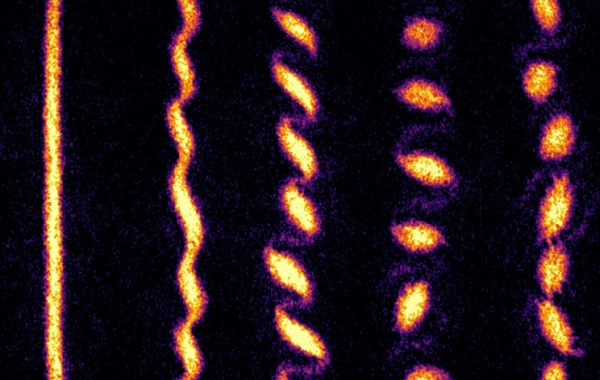Physicists at the Massachusetts Institute of Technology have announced a breakthrough in their research of quantum physics. According to a study published last month in the journal Nature, they have observed the moment in which ultra-cold atoms switch locations with one another. The study conducted by the MIT team discovered that the movement of changing locations has led to the formation of so-called “quantum tornadoes.”
Atoms in the form of a classical needle structure on the left and a series of "quantum tornadoes" on the right.To realize the awesome nature of this discovery, one will remember that two laws of physics govern the universe: classical physics and quantum physics. Classical physics governs our movements, pace, and location, all based on the law that we can only be in one place at any one time. Meanwhile, in quantum physics, particles may exist in numerous places simultaneously. These particles can tunnel through obstacles and immediately communicate information across great distances.
"This evolution connects to the idea of how a butterfly in China can create a storm here, due to instabilities that set off turbulence," explains Martin Zwierlein, an author on the research paper. "Here, we have quantum weather: The fluid, just from its quantum instabilities, fragments into this crystalline structure of smaller clouds and vortices. And it's a breakthrough to be able to see these quantum effects directly."
Zwierlein, the
Thomas A. Frank Professor of Physics at MIT, says this:
“My message to young physicists is always be curious about whatever you see. Try to understand it, and don’t think, ‘oh it’s too difficult.’”
Quantum Tornadoes:
How they are created
During the process of rotation, the round cloud of atoms is placed into an electromagnetic trap and eventually turns into a thin, needle-like structure. Afterward, the needle split into a crystalline structure, resembling a string of small quantum cyclones, at the point classical physics become inhibited, leaving only interactions and quantum rules to lead the atoms' activity.
Interestingly, the rapidly rotating quantum gas process is quite similar to the rotation of the Earth, and the rotation of the quantum m fluid of ultracold atoms gives rise to "quantum tornadoes.”
Richard
Fletcher, an assistant professor of physics at MIT and an author on the
paper, explains in a statement that
"crystallization is driven purely by interactions, and tells us we’re
going from the classical world to the quantum world." This shift is
significant since some things that seem impossible to our everyday
understanding of the world could be perfectly possible in quantum physics.
How this discovery
can be used — This
research has some potential for practical applications, such as inertial
sensors of submarine navigation. Submarines use fiber optic gyroscopes in order
to detect rotational movement when they are submerged, and this produces a
telltale interference pattern. Since atoms move slower than light, a
quantum-tornado sensor could even be sensitive enough to measure very slight
changes in the Earth's rotation.


